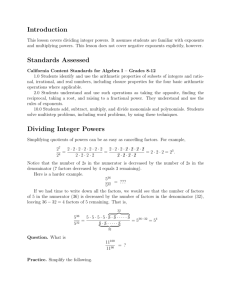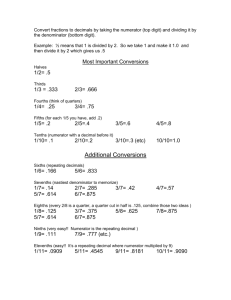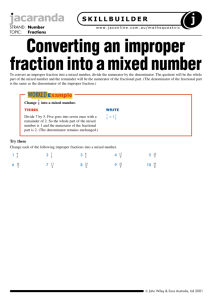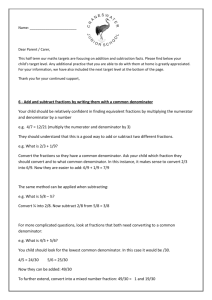Numerical Skills and Pre-Algebra
advertisement
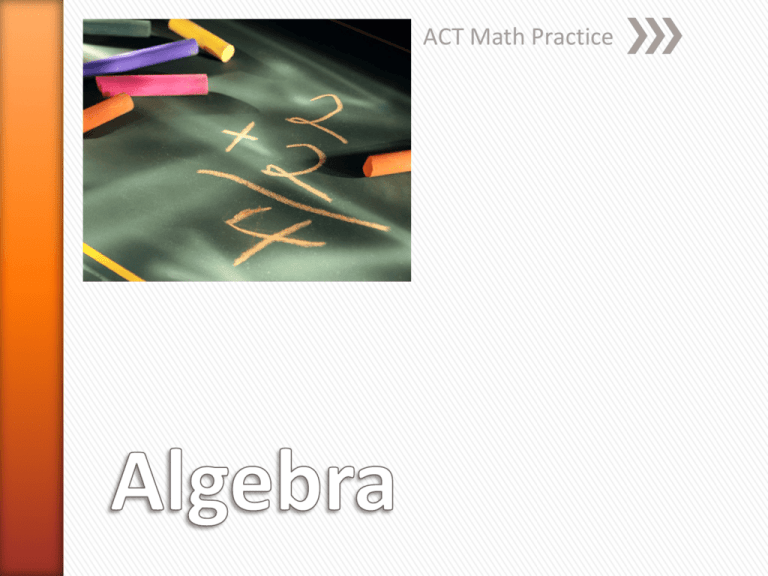
ACT Math Practice Algebra Placement Test The Algebra Placement Test is composed of items from three curricular areas: elementary algebra, coordinate geometry, and intermediate algebra. Each of these three areas is further subdivided into a number of more specific content areas. Overall, the Algebra Placement Test includes items from more than 20 content areas; however, the majority of test questions fall within the following eight content areas: » » » » » » » » 1. Substituting Values into Algebraic Expressions 2. Setting Up Equations for Given Situations 3. Basic Operations with Polynomials 4. Factoring Polynomials 5. Linear Equations in One Variable 6. Exponents and Radicals 7. Rational Expressions 8. Linear Equations in Two Variables Substitute -3 in for all x and evaluate using your order of operations. (-3)2 -1 = 8 and then (-3)+1 = -2. 8/-2 = -4. Remember if you are using a calculator, evaluate the numerator and denominator separately or be sure to use () around the whole denominator and the whole numerator. You must also use () around each of the -3 First, find this person’s MHR by subtracting 220 – 43 = 177. Then substitute the MHR and provided RHR to get THR = 54+.65(177-54). THR = 54 +.65(123) THR = 54+79.95 THR = 133.95 Because you want to do the subtraction first and then take 75% of the answer, you need to put () around the 220-a to get that value 1st then multiply by .75. Make sure that when you set up an equation here, you are using distance on both sides of the equation. The word “entire” suggests total and that means addition. First part of the flight is 8 hours at some speed x , thus 8x. Second part is 7 hours at 325 mph, thus 7(325). The plane flew an average airspeed of 350 and that was for 15 hours so…. Follow order of operations and begin by getting rid of () by distributing the negative through (-6a-3b) to get 3a+4b+6a+3b. Then combine like terms: 9a+7b. Here you want to combine like terms . Like terms have to the same variables and the same exponent for the variables. The only two that are like that here are 2a2b2 and a2b2. Since they are alike, add their coefficients, 2 and the understood 1, to get 3a2b2. Leave the order two terms as they are. The terms can be in any order here. To factor a trinomial with a one for a coefficient, you need to note the constant or number with a variable and read backwards to the middle term. Here we are looking for factors of 20 that will subtract (because of the minus sign) to give you a -1 (coefficient of x part. Factors of 20 are 1 and 20, 2 and 10, and 5 and 4. Five and four will subtract to give you a one. In order to get a -1, the five has to be negative so: x-5 works. To factor a trinomial with a one for a coefficient, you need to note the constant or number with a variable and read backwards to the middle term. Here we are looking for factors of 6 that will subtract (because of the minus sign) to give you a -5 (coefficient of x part. Factors of 6 are 1 and 6, 2 and 3, Six and one will subtract to give you a five. In order to get a -5, the six has to be negative so: x-6 works. To solve equations your goal is to get the variable by itself on one side of the equation. So here, you need to first distribute and then combine any like terms on one side of the equation. Here distribute the 2 through the (), yielding 2x-10 = -11. There are no terms on each side that can be combined so we then add +10 on both sides to get the 2x by itself. Then gives you 2x = -1. Divide both sides by 2 and get x = -1/2. Remember you can always check an equation by substituting the answer back it to see if it works. I like to multiply everything through by the least common denominator here to get rid of all of the fractions. This number is 10. If I multiply EVERY term by 10, I get: 8+-3 = 10x+15. Next, combine like terms on the left to get 5 = 10x+15. Then, subtract 15 from both sides and get -10 = 10x. Divide both sides by 10 and get -1. Method 2: Write it all out: 4*4*r*r*r*t*z*z*z*z*z -4*r*t*t*t*z*z Then mark out everything in common and your answer is what is left. Method 1 - In order to reduce a monomial algebraic fraction, begin by reducing the number portion like you always have: 16/4 leaves -4 in the numerator. Then, you do the variable portion. Since we are dividing, up steps up says we need to SUBTRACT exponents and keep the answer where the larger number of variables to begin with. For the r’s, 3-1 is 2, leaving an r2 in the numerator. Follow the same process for the t’s, and there will be a t2 left in denominator. There will be a z3 left in the numerator for the z’s so… It is incorrect to leave a radical in the denominator, so we have to deal with this. The way to get rid of a radical in the denominator is to multiply both top and bottom by the CONJUGATE of the denominator. The conjugate is the same terms in the denominator both with the sign changed in the middle. Ours is 3√x + √y. So √x (3√x + √y) / (3√x - √y)(3√x + √y). Simplify by distributing and FOILING. The numerator becomes 3x + √xy because the x*x gets rid of the radical in the first term. The denominator becomes 9x – y because the x*x and the y*y gets rid of the radical and the middle terms from FOIL add up to 0 or cancel each other. In order to reduce a multi-term algebraic fraction, you must factor everything first. Here only the numerator factors. Using the concepts from before, the factors of 32 that will add to be 12 are 8 and 4, and they must be positive to add to positive. So, we have: (x+8)(x+4) / (x+4) . Because the binomial x+4 terms are exactly alike, they reduce to 1 and can be marked out, leaving x+8. Hint: since none of the answers have a denominator (x+4) had to be one of factors of the numerator. Again, we need to factor first. The numerator is a difference of squares so it factors to (3-x)(3+x). So we have (3-x)(3+x) / (x-3). 3-x and x-3 are exact opposites so we can rewrite the denominator to -1(3x). Then the 3-x from the top and bottom will reduce leaving (3+x) / -1. Divide the numerator by the -1 and get -3-x which is the same as –x-3. BE CAREFUL WITH SIGNS HERE!!! The most common process taught is to solve for y and the slope is the your coefficient of x. So, here we subtract the 6 and the 2x over to the other side leaving 3y = -2x -6. Then divide by 3 to get the y isolated. This leaves y = -2/3 x+ -2. The slope is -2/3 because that is the coefficient of x. You can also graph the line using intercepts and count the slope, knowing that slope is rise over run. Plot A and graph the line x =2. X = 2 is vertical crossing the x-axis at 2. A is 6 units from the vertical line so if x=2 is going to bisect segment AB, then the other endpoint must also be 6 units on the other side of the line on a horizontal line so…. Remember perpendicular lines have to intersect at right angles. Horizontal and vertical lines make it easier because their slopes are special cases. A. 6 6



